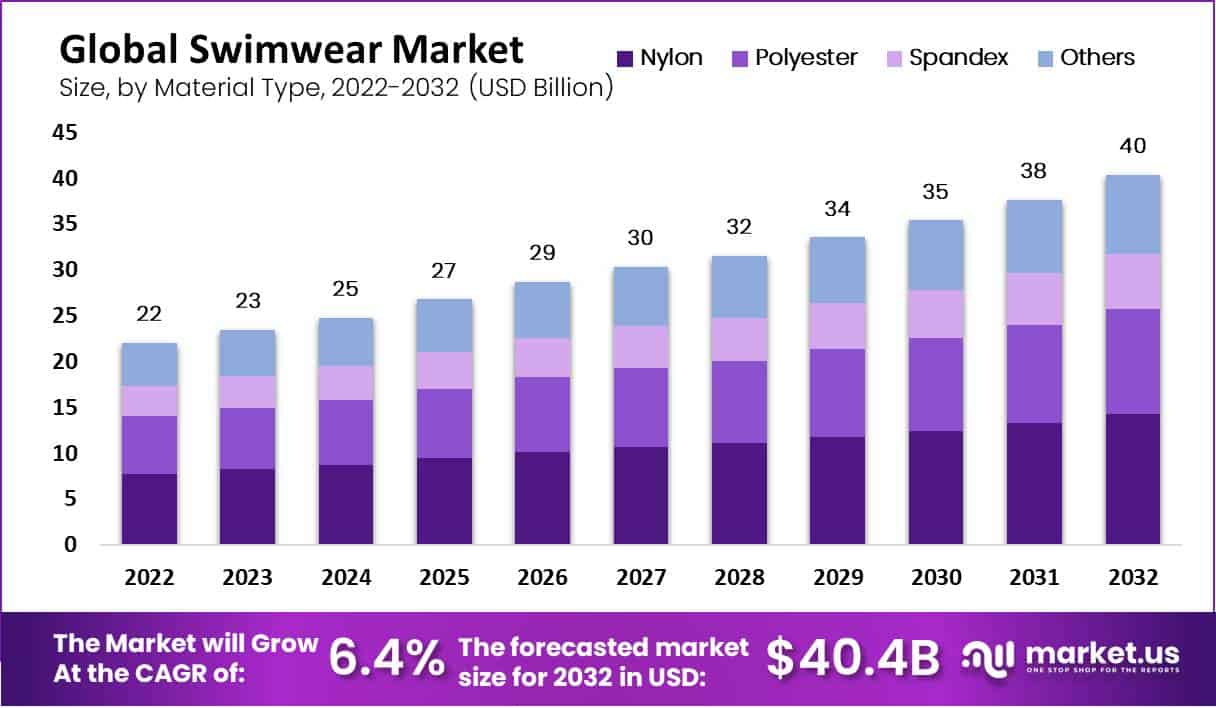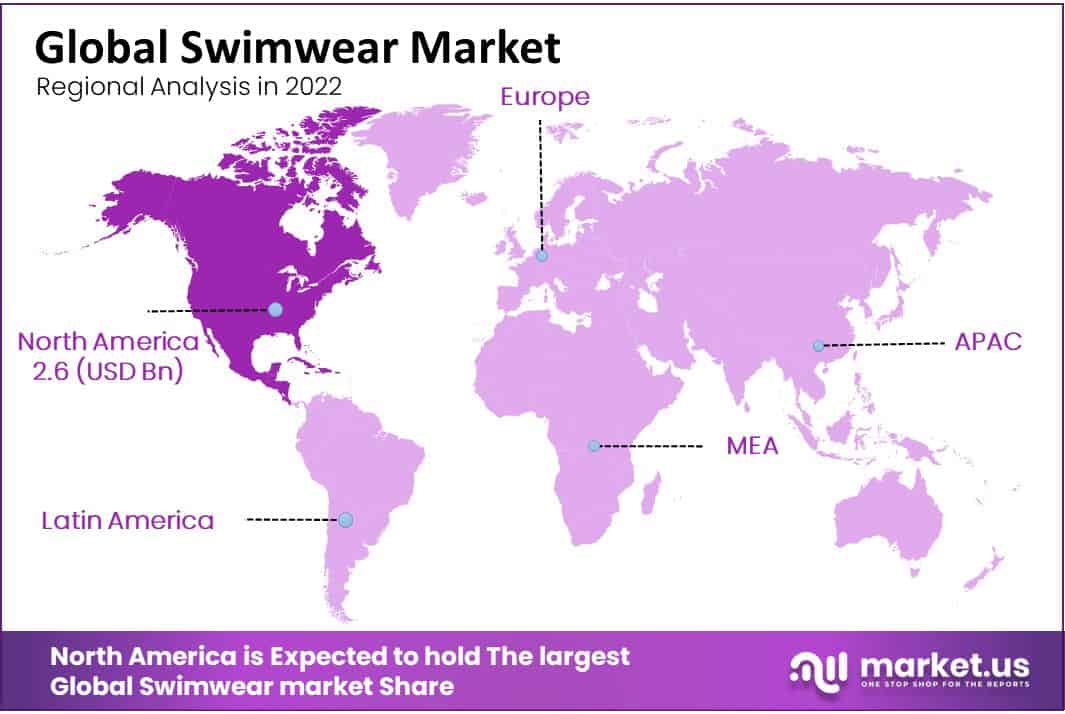Global Swimwear Market By Material Type (Nylon, Polyester, Spandex, and Others), By End-User (Women, Men, and Kids), By Region and Companies - Industry Segment Outlook, Market Assessment, Competition Scenario, Trends and Forecast 2023-2032
- Published date: Sep 2023
- Report ID: 15083
- Number of Pages: 241
- Format:
- keyboard_arrow_up
Quick Navigation
Report Overview
The Global Swimwear Market size is expected to be worth around USD 41.03 Billion by 2032 from USD 22.06 Billion in 2022, growing at a CAGR of 6.40% during the forecast period from 2023 to 2032.
Swimsuits are commonly used by people who engage in water activities such as swimming and bathing to protect the wearer from chlorinated pool water and salty seawater that can cause skin irritation.
The market is driven by a growing global population and product innovations to meet the needs of specific types of clothing for water sports and pool and beach vacations.
Rapid changes in fashion trends and rising disposable incomes of consumers are expected to boost industry demand as different types of swimwear products are purchased based on comfort, activity, and fashion appeal will be luxury swimwear with slimming effects and value-added features like comfortable cuts and trendy prints are becoming increasingly popular with women all over the world.
The growth of the beauty and spa industry and the increasing demand for specialized swimwear by women are also driving the swimwear and beachwear market to some extent. Swimming is considered the most popular fitness and leisure activity. Due to the growing interest in fitness among different age groups, the demand for swimming as the best form of exercise is increasing. This creates a roadmap for buying swimwear products in bulk.
Exposing the body is a common phenomenon in some Western countries, effectively increasing the sale of beachwear products in the market. Growth is driving the Swimwear market. The development of various types of advanced fabrics with longer color retention and chlorine resistance is further fueling the market growth.

Driving Factors
The increasing demand for long-sleeve swimsuits
Increasing demand for long-sleeve swimwear is one of the key factors behind the growth of the swimwear market. Swimming is a popular summer activity.
However, drastic changes in climatic conditions have increased the health effects of UV radiation on humans during and after swimming, especially in open areas such as swimming pools and beaches. The harmful effects of UV radiation can lead to skin tanning, skin rashes, sunburns, and, in extreme cases, skin cancer.
Vendors are now developing products to meet the growing demand for long-sleeve swimwear. For example, Boardriders Inc. swimwear brands Billabong and ROXY offer a wide range of long-sleeved swimwear in a variety of designs, sizes, and colors. Such products will drive the growth of the swimwear market during the forecast period.
Restraining Factors
The availability of counterfeit products
The availability of counterfeit products is one of the major factors expected to hinder the growth of the swimwear market.
Fake or replica products are available at prices much lower than the original prices set by organized players. This factor influences the sales and pricing strategies of the original market participants. Commodity price volatility is another key factor expected to limit market growth to some extent.
Growing Opportunities
Continuous introduction of new products by major players
Continuous introduction of new products by major players is expected to bring lucrative market opportunities. For example, in February 2021, the Phelps brand, a global swim brand offering premium and innovative swim products, announced the launch of a collection inspired by world champion swimmer Penny and her Orexiak.
The rise in swimming competition is also a key factor and is expected to provide significant growth opportunities in the near future. For example, in March 2019, FINA launched its latest swimming competition on April 27-28. The first meeting of the inaugural edition of the FINA Champions Swim Series opens the 2019 three-part circuit in Guangzhou, China.
Latest Trends
The importance of sporting activities, especially for health reasons, and the increasing number of international sporting events, encourage people to participate in sports and leisure activities. The increasing number of people participating in fitness and water sports has given players the opportunity to introduce stylish and comfortable swimwear suitable for swimming and other water sports activities.
Many people tend to choose swimming as their fitness regimen because swimming has its benefits. The growing number of campaigns to improve participation in swimming in various countries has also contributed significantly to the increase in demand for swimwear in recent years. These campaigns have encouraged more consumers to participate in swimming. And strengthen links between communities and sports organizations.
Material Type Analysis
Incorporating Advanced Fabrics Into Swimwear Manufacturing Is Expected To Boost Global Market Growth
By type, the market is segmented into, nylon, polyester, spandex, and others. In 2022, polyester accounted for the largest share at 33.4%. Various types of swimwear are made of polyester for stretchability and shrinkage resistance. In addition, the quick-drying and easily washable properties have increased the demand for this material among manufacturers.
In addition, benefits such as resistance to wrinkles, abrasions, and most chemicals make the swimwear more durable. Therefore, incorporating advanced fabrics into Swimwear manufacturing is expected to boost the global market growth.
Nylon is another important fabric type on the market due to its excellent stretch, lightweight, and smooth fit. It is used as an alternative fabric to polyester. Nylon fabrics are slow to grow in the Swimwear market due to their lack of chlorine resistance and durability compared to polyester.
End-User Analysis
The Female Segment Dominates The Market In this Segment
The female segment had the largest market share in 2022 and is projected to grow during the forecast period. There is an increasing demand for swimwear for women who want to look stylish at the pool or beach.
New trends such as bold color schemes, geometric prints, asymmetric designs, and classic yet modern shapes are also boosting the demand for women’s swimwear. Therefore, designers update swimwear and beachwear regularly and without delay. Increased demand for certain types of swimwear, such as B. Thermal swimwear and swimwear with UV protection, will boost the female consumer base.

Key Market Segments:
Based on the Material Type
- Nylon
- Polyester
- Spandex
- Others
Based on End-User
- Women
- Men
- Kids
COVID-19 Impact Analysis
In 2020, the COVID-19 outbreak had a negative impact on the region’s trade and economy as a whole. However, with the start of a vaccination campaign in early 2021, factories, warehouses, and other facilities operated by local suppliers have reopened.
The reopening of leisure facilities such as pools and swimming competitions has increased the demand for swimwear. Such factors thus drive the growth of the regional swimwear market during the forecast period.
Regional Analysis
Asia Pacific has the Largest Market Share In this market
Asia Pacific has established itself as the largest regional market for swimwear products. Population growth, rising health awareness, and product innovation are expected to boost market growth in the developed countries of the region. Moreover, the domestic growth of water sports and fitness in developing countries such as China and India is expected to have a positive impact on the growth of the regional market.
Some of the factors contributing to the market growth are the cumulative growth of the water fitness and water sports industry, the rise in the number of hotels and homes with swimming pools, and the tourism industry, particularly in Singapore, Thailand, Japan, and other nations.
Countries will push demand even further. North America is expected to be the second largest region, and factors contributing to the growth of the Swimwear market are one of the largest economies, with more swimwear-wearing vacationers and the popularity of beach volleyball in the region increasing. Most of the population can swim, and some others use swimwear.

Key Regions and Countries:
- North America
- The US
- Canada
- Mexico
- Latin America
- Colombia
- Chile
- Brazil
- Argentina
- Costa Rica
- Rest of Latin America
- Eastern Europe
- Russia
- Poland
- The Czech Republic
- Greece
- Rest of Eastern Europe
- Western Europe
- Germany
- France
- The UK
- Spain
- Italy
- Portugal
- Ireland
- Austria
- Switzerland
- Benelux
- Nordic
- Rest of Western Europe
- APAC
- China
- Vietnam
- Japan
- Indonesia
- South Korea
- India
- Australia & New Zealand
- Singapore
- Thailand
- Malaysia
- Philippines
- Rest of APAC
- Middle East & Africa
- Algeria
- Egypt
- United Arab Emirates
- Saudi Arabia
- Kuwait
- Nigeria
- Israel
- South Africa
- Turkey
- Rest of the Middle East and Africa
Major players in the swimwear market include Jantzen Apparel LLC, NoZONE Clothing Limited, La Perla Group, PVH Corp, Arena Italia S.p.A., Quiksilver, Inc., American Apparel, Inc., and Nike.Inc. and others. These players are focused on producing the best possible designs and quality fabrics to attract more consumers to their products. The global swimwear market is dominated by types, and distribution channels, Split by end-user and region.
Key Players in Swimwear Market:
Listed below are some of the most prominent Swimwear industry players.
- Adidas AG
- Marysia LLC
- Pentland Group PLC
- Nike Inc.
- Wacoal Holdings Corporation
- Arena SpA (Berkshire Hathaway)
- Swimwear Anywhere Inc. (TYR Sports Inc.)
- Tennor Holding BV (La Perla)
- La Jolla Group
- LVMH Moët Hennessy Louis Vuitton
- TJ Swim
- Other Key Players
Recent Developments:
- June 2022: A new line of swimwear from H&M of Sweden features brightly colored one-piece suits and bikini tops. bright green, Purple, white, and dark chocolate brown are among his prints that also feature multicolor artistic designs. Some items also have adjustable straps.
- March 2022: The Skims brand has partnered with Italian fashion house Fendi to launch a unique 2021 collection that includes the Fendi x Skims ready-to-wear collection. The collection includes swimwear, fitted dresses, and tops starting at $950.
- October 2021: The Chanel group presented his 90s-inspired Spring/Summer 2022 collection at Paris Fashion Week.
- In December 2019, Nike announced the launch of swimwear for athletes. This new product comes with a one-piece or separate or full-body swimsuit consisting of a tunic top, floating hijab, and leggings.
- In September 2018, Chanel announced the acquisition of the British resort and swimwear brand Orlebar Brown. The acquisition will help Chanel have greater influence in the UK.
Report Scope:
Report Features Description Report Features Description Market Value (2022) USD 22.06 Bn Forecast Revenue (2032) USD 41.03 Bn CAGR (2023-2032) 6.4% Base Year for Estimation 2022 Historic Period 2016-2022 Forecast Period 2023-2032 Report Coverage Revenue Forecast, Market Dynamics, COVID-19 Impact, Competitive Landscape, Recent Developments Segments Covered By Material Type: Nylon, Polyester, Spandex, and Others; By End-User: Women, Men, and Kids. Regional Analysis North America – The US, Canada, & Mexico; Latin America – Brazil, Colombia, Chile, Argentina, Costa Rica, and rest of Latin America; Eastern Europe – Russia, Poland, The Czech Republic, Greece, and rest of Eastern Europe; Western Europe – Germany, France, The UK, Spain, Italy, Portugal, Ireland, Austria, Switzerland, Benelux, Nordic, & Rest of Western Europe; APAC – China, Japan, South Korea, India, Australia & New Zealand, Indonesia, Malaysia, Philippines, Singapore, Thailand, Vietnam, & Rest of APAC; Middle East & Africa – Algeria, Egypt, Israel, Kuwait, Nigeria, Saudi Arabia, South Africa, Turkey, United Arab Emirates, & Rest of MEA. Competitive Landscape Adidas AG, Marysia LLC, Pentland Group PLC, Nike Inc., Wacoal Holdings Corporation, Arena SpA (Berkshire Hathaway), Swimwear Anywhere Inc. (TYR Sports Inc.), Tennor Holding BV (La Perla), La Jolla Group, LVMH Moët Hennessy Louis Vuitton, TJ Swim Customization Scope Customization for segments, region/country-level will be provided. Moreover, additional customization can be done based on the requirements. Purchase Options We have three licenses to opt for Single User License, Multi-User License (Up to 5 Users), Corporate Use License (Unlimited User and Printable PDF) Frequently Asked Questions (FAQ)
What is the Swimwear Market size in 2022?The Swimwear Market size is USD 22.06 billion for 2022.
What are the segments covered in the Swimwear Market report?Market.US has segmented the Global Swimwear Market Value (US$ Mn) Analysis by Region, 2022 market by geographic (North America, Europe, APAC, South America, and Middle East and Africa). Based on Material Type,market is segmented into Nylon, Polyester, Spandex, Others. Based on End-User,market is segmented into Women, Men, Kids.
Who are the key players in the Swimwear Market?Adidas AG, Marysia LLC, Pentland Group PLC, Nike Inc., Wacoal Holdings Corporation, Arena SpA (Berkshire Hathaway), Swimwear Anywhere Inc. (TYR Sports Inc.), Tennor Holding BV (La Perla), La Jolla Group, LVMH Moët Hennessy Louis Vuitton, TJ Swim, Other key players are the key vendors in the Swimwear Market.
Which region is more attractive for vendors in the Swimwear Market?Asia Pacific has established itself as the largest regional market for swimwear products. Population growth, rising health awareness, and product innovation are expected to boost market growth in the developed countries of the region.
What is the CAGR for the Swimwear Market?The Swimwear Market expected to grow at a CAGR of 6.4% during 2023-2032.

- Adidas AG
- Marysia LLC
- Pentland Group PLC
- Nike Inc.
- Wacoal Holdings Corporation
- Arena SpA (Berkshire Hathaway)
- Swimwear Anywhere Inc. (TYR Sports Inc.)
- Tennor Holding BV (La Perla)
- La Jolla Group
- LVMH Moët Hennessy Louis Vuitton
- TJ Swim
- Other Key Players
- settingsSettings
Our Clients
| Single User $4,599 $3,499 USD / per unit save 24% | Multi User $5,999 $4,299 USD / per unit save 28% | Corporate User $7,299 $4,999 USD / per unit save 32% | |
|---|---|---|---|
| e-Access | |||
| Report Library Access | |||
| Data Set (Excel) | |||
| Company Profile Library Access | |||
| Interactive Dashboard | |||
| Free Custumization | No | up to 10 hrs work | up to 30 hrs work |
| Accessibility | 1 User | 2-5 User | Unlimited |
| Analyst Support | up to 20 hrs | up to 40 hrs | up to 50 hrs |
| Benefit | Up to 20% off on next purchase | Up to 25% off on next purchase | Up to 30% off on next purchase |
| Buy Now ($ 3,499) | Buy Now ($ 4,299) | Buy Now ($ 4,999) |












